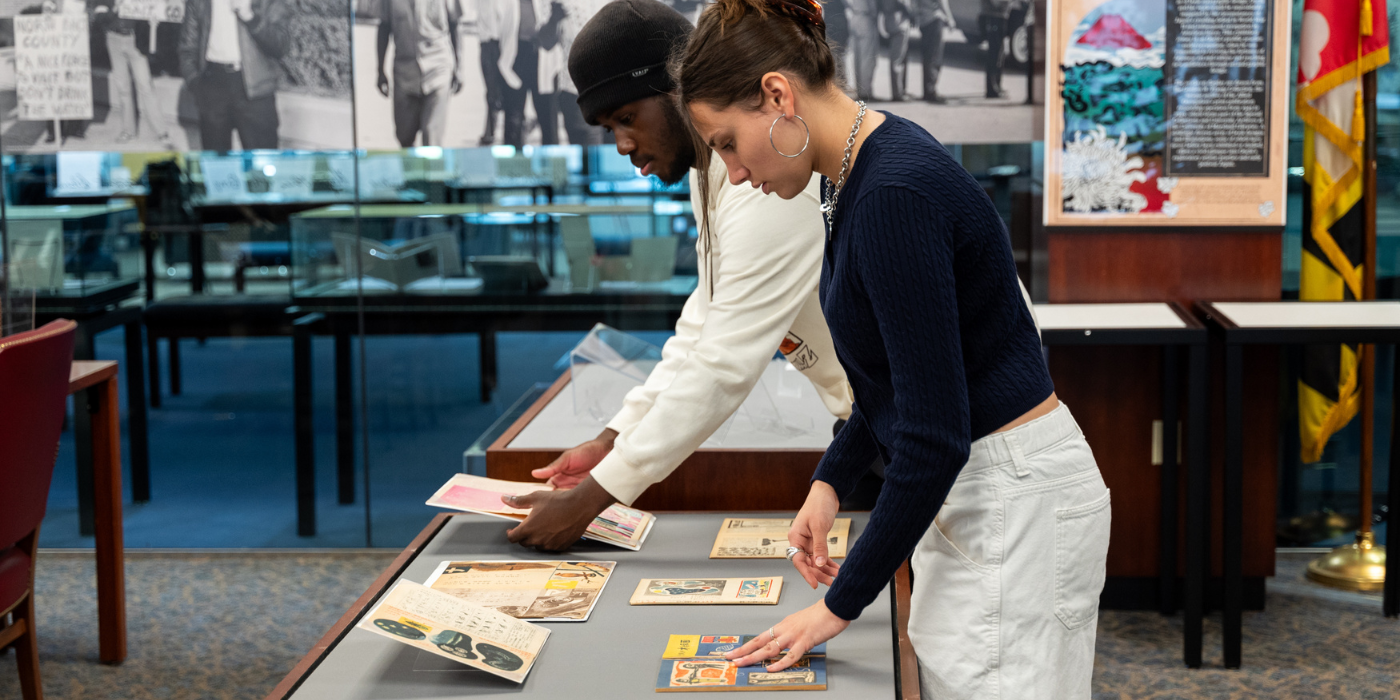Student-curated exhibition features one-of-a-kind pieces from UMD Libraries’ Prange Collection
In Hornbake Library’s Maryland Room, a semester of collaborative experiential learning and student work culminates in a stunning exhibition on the work of Japanese artist Onchi Kōshirō.

Over the course of the fall semester, the undergraduate students in Dr. Alicia Volk’s Japanese Art in the 20th Century colloquium class (ARTH488J) spent hours on the fourth floor of Hornbake Library. That floor houses the Gordon W. Prange Collection, a vast and unique archive of rare Japanese print media consisting of books, magazines, newspapers, posters, maps, and other printed publications that were subjected to censorship by the occupying American forces from 1945 to 1949. Here, the students worked with Prange Collection curator, Kana Jenkins, and other members of the Prange Collection staff to create the exhibition “Onchi Kōshirō, Graphic Artist: Picturing Postwar Japan.”
From conception to piece selection to set up and outreach, the students had a hand in every part of this exhibition, including research, deciding themes, selecting works for display, designing the displays, writing captions and other explanatory text, creating promotional materials, and conducting various outreach activities.
“For the first few weeks, it felt like we were drowning in ‘to dos,’” said Sofia Ruben, a senior in Dr. Volk’s class. “We needed to figure out what story the items were going to tell, themes for each display case, and how many items we could include. There were many days spent at the Prange Collection sorting through archived materials where I had no clue what I was doing.”
But the student persevered and the exhibition “Onchi Kōshirō, Graphic Artist: Picturing Postwar Japan” came to fruition. Onchi Kōshirō (1891-1955) was one of the twentieth century’s most innovative artists. A Japanese pioneer of abstraction and printmaking as well as of book and graphic design, Onchi and his work would be unavoidably impacted by the circumstances of Japan’s defeat in World War II and subsequent occupation by American forces. This exhibition focuses on Onchi’s prolific practice under occupation, when he was committed to reviving the fortunes of Japanese art and culture and reaching new audiences through art and graphic design.
For first year student Connor Grabowski, his epiphany came when they started placing their curated objects in the display cases. “All of us walked in a little nervous about our ability to successfully pull together an exhibition,” said Grabowski. “Many of the larger exhibitions we used as reference for ours had years of preparation time. We had a little over a month. When the items were actually in the cases, I finally truly believed the exhibition would be done in time.”
He continues, “As a first semester freshman, a lot of what the university has to offer is still very unknown to me. Having an introduction to a small part of the archival collections, the behind the scenes of campus exhibitions, and professors’ academic research really illuminated just how many resources and opportunities are available to students!”
The exhibition was designed to complement “The Print Generation” exhibition at the National Museum of Asian Art, Smithsonian Institution, in Washington, D.C. (open November 16, 2024 to April 27, 2025). Both exhibitions feature artworks by Onchi Kōshirō. While “The Print Generation” includes woodcut prints by multiple “creative print” or sōsaku hanga artists active in Japan in the 20th century, this exhibition focuses almost entirely on Onchi, one of the movement's most prominent leaders.
“Onchi Kōshirō, Graphic Artist: Picturing Postwar Japan” is on display in the Maryland Room on
the first floor of Hornbake Library through January 2025. The exhibition is free and open to the public Mondays through Fridays from 10 a.m. to 4 p.m.